
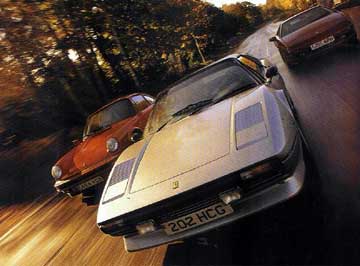
Shopping for a Supercar
Autocar Magazine
December 1996
You may think a supercar is out of your league, but, for
the price of a Ford Scorpio,
you could howl down your local streets in a Ferrari 308, a Porsche 911, or
a Lotus Esprit, says Andrew Frankel
If you drive a Ferrari 308 down a straight piece of road and flick the eight carburettor chokes wide open at 5000rpm, you will discover that it makes a noise which, if you have not experienced such a car before, will most likely change your life.
It is the Ferrari howl and, irrespective of engine capacity and cylinder quantity, they all do it. In all its myriad forms it is utterly and uniquely addictive. It is a terrible shame that all you can see on these pages is how good a 308 looks because, compared to the way it sounds, it looks like a Trabant.
The snag is that popular perception tells us that Ferrari are either impossibly expensive to buy or impossibly expensive to run, very often both. Popular perception, however, does not always know or tell the truth.
The truth about Ferraris is this: there are some nightmares out there, from smoking automatic 400i which looks such a snip at £15,000, to that beautiful Daytona that turns out to be a bucket of bolts in need of a total rebuild. This story is not about such cars. The Ferraris we want to talk about are not the concours winners, but those that have been loved and cherished, driven hard as all Ferraris should be, but never abused. The sort of Ferrari that can be yours for rather less than the price of Ford's flagship Scorpio.
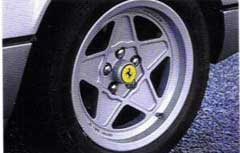
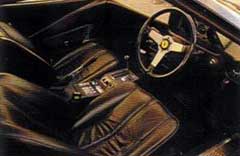
Thirty grand will buy you a 308GTS like the delightful, 40,000 mile, 1979 example pictured here. If you wish to do without the lift-out roof panel, the GTB coupe not only costs about £3,000 less, it is also slightly prettier and better to drive. A GTB from 1976 or early '77 will cost proportionally more thanks to its glass fibre bodywork. This makes the car not simply lighter and quicker, but also free from the appalling body rot that affects all Ferraris from this era if less than scrupulously attended to.
If you cannot stretch to this kind of money, the 308GT/4 will provide all the aural thrills for up to £10,000 less. Bodied by Bertone and with alleged two-plus-two accommodation, its less than stunning styling and compromised interior means that tidy examples can be found for £20,000, although any buyer should approach armed with all the available knowledge and a rabidly suspicious outlook: their accessibility means that bodged and abused nightmares about.
The final route to a cheap 307 is to buy one of the first fuel injected cars, called the 308 GTBi and made from 1980-81. There is little wrong with such a car (if you can find one) except that the emissions legislation, which forced the change from four downdraught Webers to fuel injection, also slashed power from a claimed 255bhp (probably 235-240bhp) down to a measly 214bhp. Shorter gearing helped cover the cracks, but it was only when the 32-valve Quattrovalvole appeared that the 240bhp output and 150mph potential was returned.
There is, however, a snag with buying any Ferrari of this vintage in less than fully rebuilt, concours condition. They are not, and should not be treated like, everyday cars. Servicing is hideously expensive, and while fundamentals such as the engine are incredibly strong if cared for, meaning that a Ferrari will rarely fail to reach its destination, the more boring bits are far less robust and, when they break, are expensive to replace. The owner of the test car does up to 3000 miles a year including track days and finds it an endless delight. That is how to enjoy a Ferrari. It is not a Porsche 911.
This 911, though similar in size, power output and speed to a 308, does a job so different that it is almost as if they are not in the same class. This is a late Carrera, born just before the Carrera 2 brought the single biggest change to the 911 in its 33-year career, And it is – specials such as the CS and RS models aside – the most characterful of all made in the past 20 years.
Even so, you should probably not buy one for that. You buy a 911 because it is the most usable supercar ever made. A 911 that does not sit in traffic, howl up motorways, flog round tracks and barrel down B-roads while clocking up 20,000 miles a year is a 911 that is not being used to its full potential. Cars with as great a sense of unburstability include certain diesel-powered Mercedes, the odd Volvo and the Volkswagen Beetle; little else comes close.
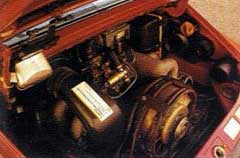
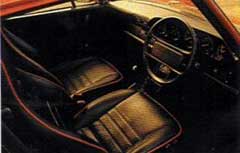
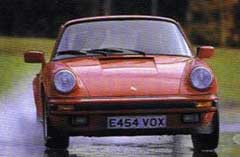
The 1987 test car is a brilliant example of the breed: a fully documented Porsche main dealer service history; body and interior not so clean and you'd worry about inevitable dings and scratches; and, best of all, just 60,000 indisputable miles on the clock, making a car very probably no more than a third of the way through its working life. Negotiations start at £24,000.
They are, however, several snags. Most obvious is the fact that this example dates from the days when 911-shaped holes in hedges on the outside of greasy roundabouts were an all too common a sight. Neither its handling nor its brakes' tendency to lock in the wet is lethal – characteristics once known – buy only a fool would take liberties with a Carrera in the wet. Equally famous faults include the ergonomically insane interior, disastrous gearchange and the unfathomable heating system.
The reasons for buying our last contender could not be more different. This Lotus Esprit is nothing like as gorgeous to look at or listen to as the Ferrari, nor will in prove as durable as the 911; though it should be said that this '94 S4 has withstood its first 50,000 miles incredibly well. No, there is but one reason for spending as much as £30,000 on this immaculate S4: there is scarcely a finer driving experience on the roads.
Everyone knows about the Esprit's faults: the appalling reliability of the early cars; the cramped cabin; lousy ventilation; joke gearbox. Yet it takes but one decent stretch of twisting road to forgive all the above and more. The simple truth is that, until they built the Elise, the Esprit was very probably the finest handling road car you could buy.
Three cars from three decades, each with an interpretation of the art of the useable supercar as individual as it is possible to be, while remaining within the genre. Their uniting factor is that they are all within the financial grasp of thousands who may never have considered themselves capable of owning such cars and who, after their first test drive, would wonder how they could ever have done without.
Least appealing at first is the Lotus. It makes your life difficult even as you try to get in through the narrow door aperture, and, once installed, there is little to be seen in the cabin or heard from the 264bhp, 2.2 litre four that smacks of anything special. You will, however, stay with it because you know of its 5sec 0-60mph potential and 160mph top speed. Oddly, however, its straight-line speed is curiously unappealing in reality. Yes, it's hugely fast; but so characterless is the lag-prone engine and so stodgy is the gearbox that, combined with merely adequate brakes, it loses almost entirely that quality of performance that those who drive the slower Ferrari and Porsche will know so well.
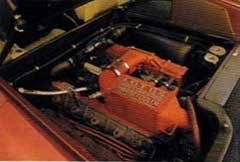
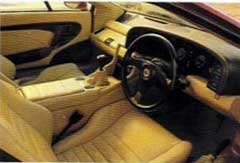
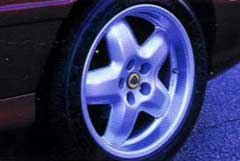
In the curves, though, it is matchless. For a start, grip is beyond the imagination of either rival, but this is not what makes it a great. It is the fluency, the effortless way that the Lotus flows through bends, the ceaselessly communicative steering and the endless efficiency with which the suspension mops up all the obstacles in your path without ever allowing the rear to become unsettled. It is a car that you drive with your fingertips, breathtakingly economical with roadspace and personal effort, content in the knowledge that, if the limit is reached either by accident or design, few will look after your interests better than the Lotus. Drive carefully and within the limits of both yourself and the Esprit, and you'd still leave the hard-driven Porsche and Ferrari wondering which way you went.
What, then, of the 911? Lacking the pace of the Lotus and the grace of the Ferrari, it would be easy to conclude that it is the one to choose only because it is cheaper, and that the sad reality of life means that its inherent strength and reliability makes its selection more inevitable than automatic.
The 911 does not need such charity. It may not be quite so dynamically accomplished as the Lotus, but if it's raw excitement that you want, you've come to the right place. Its 3.2 litre, flat-six motor may lack the four camshafts of the Ferrari and the four valves per cylinder of the Lotus, but, for throttle response, character and a searing engine note, Porsche has yet to build a better 911.
If you believe that modern cars take too much away from the driver, then the 911 presents exactly the right challenge. And the reward is the unique satisfaction of knowing that you are driving a 911 well. In a 911, everything happens earlier than usual – at least if you're doing it right. You brake earlier, turn in a little soon to accommodate that whiff of understeer than tells you the throttle is correctly balanced, and then, on or before the apex, start drawing heavily on the 231bhp that's waiting on your every request. Driven like this, an early '80s 911 is not to be feared, even when the back breaks loose. A swift correction and a stout heart will see you through.
The Ferrari, like so many of this most hyped of marques, threatens to disappoint. It's not as quick as the 911, let alone the Lotus, and needs at least as much care as the Porsche in slippery autumn weather. It may not lock its brakes quite so readily, but it greets an inappropriate and destabilising prod of the throttle with considerably less equanimity. Oh yes, 308s bite.
What's left is a car which is slowest, trickiest and the most expensive to own. All it has over the others is its powertrain, looks and badge. Is it enough? Of course. To drive along, listening to the quad-cam V8, hearing the scrape of the gear lever in its open gate and glancing down at the beautiful Momo steering wheel, with its three alloy spokes and black prancing horse on its yellow centre, is about as profound a motoring experience as they come. Barrelling a 911 out of a hairpin doesn't come close. The simple knowledge that this car was born in Maranello, that Enzo would have walked past it as it was being built, gives it a legacy unlike that of any other car on earth.
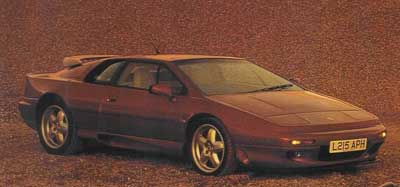
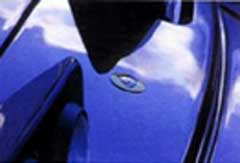
Were it my money, I'd approach the three knowing that my first supercar should be the Lotus, Not only does it more than look the part, buy it and you'd have convincingly the quickest and best to drive in those situations where supercars excel themselves. I know, however, that I couldn't walk past the 308 to get to it. It's a simple thing, but I have never dreamed of the day when I would buy my first Lotus: the day I come into Ferrari ownership occupies my mind as much not as it did when I was a child. Millions the world over feel the same way. It would be an opportunity I would find incredibly hard to pass by.
But pass it by I would, because the one I would buy is the 911. Knowing that a good one will let you down with a similar frequency to the appearance of Hally's comet more than makes up for its shortfalls. Buying your first supercar is so much more than raising the steam to write the cheque. Whatever you buy has to reward that investment with more than mere pride of ownership; it has to work. I know that while there would be time when I would much rather be in either the Ferrari or Lotus, there would be hundreds more, those occasions when the roads or conditions were not exactly right, when I would sit back in my 911, comfortable in the knowledge that nothing was going to stop me from completing today's journey, tomorrow's journey and the one the day after that.
Dream Drives in Real World
John Dennis has never owned a foreign car. Not that he's a table-thumping patriot, it's just that he's the Dennis that makes Dennis fire engines, coaches and lorries. He builds British and likes to buy it. Some would consider that buying and running seven Lotus Esprits over a 14-year period was carrying the flag a bit too far. After all, Lotuses are notoriously unreliable, aren't they? Not in Dennis's experience.
"I started with an Esprit S2, which I bought because my neighbour had one and loved it. The S2 was nice, but not that powerful. Each time I've bought a new Esprit it's been quicker and better built. I've only had one bad experience, which was when an engine went bang soon after I bought the car. Still, Lotus sorted it out without quibbling so it didn't cause me any stress. I bought my current S4 from local dealer Bell & Colvill two years ago and have since done 26,000 miles in the car. I use it every day, and any time that I don't need to cart the family around. The car came with two years' free service, but I've just had the first paid-for servicing. They tend to cost between £400 and £500 – much less than a Porsche or Ferrari, that's for sure."
Simon Low has also done his bit for Queen and domestic car industry with long string of TVRs. The line was broken by a 1988 Porsche 911 bought in 1989 with a mere 11,000 miles on the clock. Low used his E-registration car every day for his cross-London commute to the office.
"The Porsche has always been billed as the supercar for daily use, and mine hasn't disproved the theory. It's now done 26,000 miles and still feels tight and drives perfectly. The car had to have a new clutch, which is probably a result of all the town driving, and a new set of tyres. Otherwise it's hardly been touched. It's serviced at a main agent, mainly to keep the history intact. At around £900 a shot I'm probably paying more than I would at a non-franchised specialist."
Low doesn't intend to sell his 911, even though its role as daily transport has been taken over by a Honda Civic. He still loves the Porsche, though not quite as much as this Ferrari.
"I'd always lusted after a Ferrari and bought my 308GTS in 1993 for £28,000. A good price, especially for a car with only 22,000 miles on the clock. It's done 29,500 now, nearly always in fine weather. Not that I mollycoddle the thing. Owners' club track days are the most fun. A few minutes around Silverstone and I remember why I bought the car. So far it's been totally reliable. The car is serviced by specialist Kevin O'Rourke at Moto Technique. About £1,000 covers the service and the minor bits of fettling that need to be done.
"I still love the 911, but it doesn't quite deliver the experience, the pride of ownership, that the Ferrari does. That said, I've no intention of replacing it, or the Ferrari. They make a perfect pair."
|
|